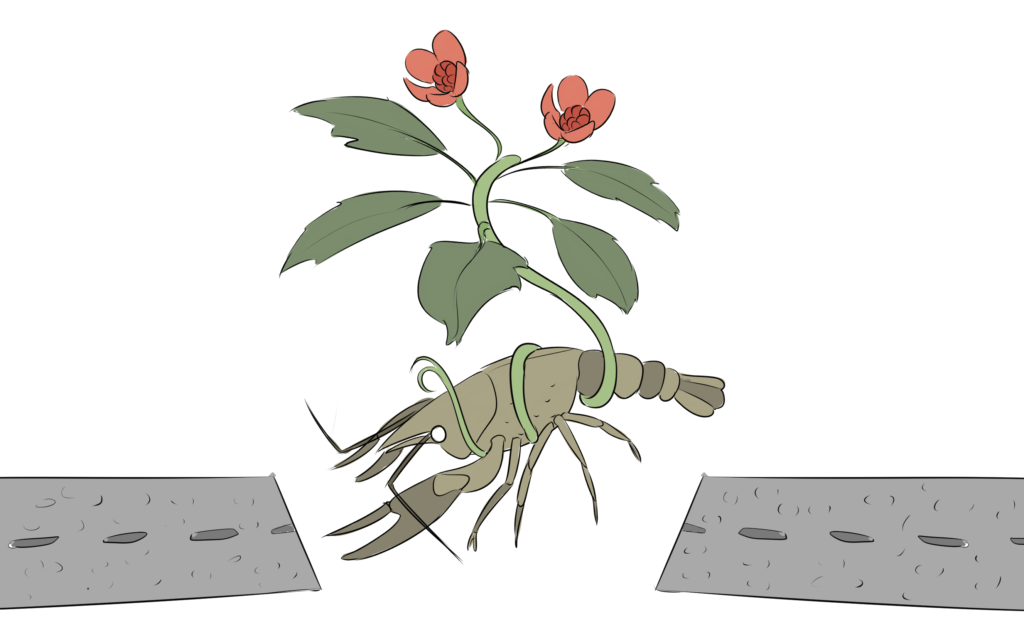
April Lawyer/ Staff Cartoonist
Walking around Emory University’s campus, students are constantly reminded of the college’s ostensible dedication to environmental justice — recycling bins, solar panels and banners emphasizing the University’s commitments to sustainability proclaim positive change for Emory.
However, it is questionable how much of this supposed commitment to sustainability is driven by a genuine desire to fight against climate change, rather than to gain gold ratings in Sustainability, Tracking Assessment and Rating System reports or rank highly in The Princeton Review’s annual guide to green colleges. The University is once again facing a conundrum regarding its true values in light of the PATH Foundation’s recent proposal to build a multi-use trail on Emory property, including in Lullwater and Wesley Woods, to connect the Clairmont campus with Old Briarcliff Road.
“This project is still in the early design and feasibility stages,” Assistant Vice President of University Communications Laura Diamond wrote in an email to the Wheel. “At this point, PATH is doing a feasibility study.”
In light of heated pressure against the proposal, Emory and the PATH Foundation are attempting to reassure the numerous student groups protesting the potential path by proclaiming that the trail’s plan is not fully finalized and could potentially be changed based on students’ interests.
Though the pathway is being painted as a fruitful endeavor that would enhance pedestrian and biking commuters’ access to Emory, it has deservedly faced major opposition because, if implemented, it would take up space without providing any tangible benefits for students. Emory Bike Social, one of the most vocal campus groups campaigning against this proposal, has already conducted a survey of 81 students to gauge how this proposed pathway would benefit bike commuters. Through their research, the group learned that a majority of respondents arrive from areas that would not intersect with the path and thus would not have an impact on their commute time. Numerous bikers also expressed concern at the PATH Foundation’s plan to construct the trail with raised, wooden slats as it would become even harder for biking commuters to safely ride over the hilly terrain while also trying to maintain balance.
Emory Bike Social President Alison Thieberg (25C) said that the trail would serve as a “friendly” recreational biking route, but emphasized that biking conditions could be better improved if bike lanes were maintained and implemented on Emory’s more popular roads, like Clifton Road, instead.
It is almost incredulous that Emory’s premier undergraduate biking club is against a proposal that was originally presented as a saving grace for bike commuters and that the PATH Foundation did not consider undergraduate bikers’ concerns when drafting their plan.
In its current state, the proposal would also disrupt the habitat of two state-protected species — the Chattahoochee crayfish (Cambarus howardi) and bay starvine (Schisandra glabra) — as well as encourage the spread of invasive vegetation into Emory’s forests. By providing a large, accessible pathway in Lullwater, Emory would be expanding development in this area already damaged from streambank collapse and ecologically-sensitive habitat. In turn, the proposal would further endanger the lives of rare species that could easily be squashed and walked over, while curtailing the progression of field studies intended to preserve these species.
Despite the PATH Foundation and Emory administrators’ claims that the proposal is not set in stone and is simply being used to measure student organizations’ collective interest, Campus Services has already acted to minimize student concerns by excluding essential information about the threatened rare species during University meetings about the proposal. They have also ignored the illuminating and condemnatory Nov. 16 memo from the University Senate’s Committee on the Environment, which states the Committee’s opposition to the proposal. In response, Campus Services claimed in their Nov. 22 presentation that there is actually very little student resistance to the proposal.
It is clear that advocates for the path are just clambering for support rather than actually taking into account students’ grievances with the proposed pathway.
“I feel that administrators are cherry picking support for their proposal without supplying sound science that it will not have major impacts,” Emory Ecological Society President Nick Chang (24C) said. “The burden of proof should be on Emory to demonstrate that this trail is safe, rather than on bodies like the University Senate Committee on the Environment to prove that it is dangerous.”
It is absurd that students and faculty’s valid concerns about the severe ecological damage to state-protected species and habitats that will be caused by the path are being dismissed and treated as unsubstantiated claims.
“If there are any endangered species related to the project, we will identify them and protect them,” Senior Transportation Planner for the PATH Foundation Eric Ganther wrote in an email to the Wheel.
It is unclear how exactly the PATH Foundation plans to balance addressing the different grievances of both Emory’s biking and environmental groups. Decisions made in favor of the biking groups, like building a wider and more structurally-sound pathway with materials like concrete, would more harshly impact the Emory forest and the rare species existing there. However, when the proposal tries to prioritize environmental concerns, like by removing lights along the pathway to not further disturb the species’ natural sleep tendencies, it would risk the lives of bikers who would not even want to ride in such dangerous conditions.
“The happy medium that [the PATH Foundation is] trying to reach is just not feasible currently,” Thieberg said.
Thieberg indicated that the University should weigh the other options on their plate, like widening bike lanes and filling in dangerous potholes, that might be more beneficial to biking commuters.
Despite grave missteps in regard to the PATH proposal, it is impossible to say that Emory has not made substantial moves forward in the name of environmental protection. The University pushed the needle forward by supporting student contributions to environmental policy at the 2022 United Nations Framework Convention on Climate Change and initiatives like Plastic Free Emory. However, the key denominator in every instance of monumental environmental change has not been the University — it has been the work and dedication of student activists.
It is vital that Emory students stand together in efforts of environmental advocacy like opposing the PATH Foundation proposal that will ignore the harsh realities of soil compaction and erosion in favor of a visually appealing paved trail. The Student Government Association, which has already indicated strong opposition to the proposal on March 26 through Resolution 56s102, and College Council need to take further actions based on students’ beliefs and perspectives to make the correct decision for our community and the environment’s future. While it may be less popular to strip an aesthetic pathway away from students, ultimately, leisurely activities and desires should not overshadow the conservation and protection of threatened species and their natural habitats.
Opinion Editor Ellie Fivas (24Ox) serves as Oxford-Atlanta Liaison for the Oxford and Emory Student Government Associations. She was not involved in writing or editing this editorial.
The above editorial represents the majority opinion of the Wheel’s Editorial Board. The Editorial Board is composed of Isabelle Bellott-McGrath, Evelyn Cho, Ellie Fivas, Marc Goedemans, Elyn Lee, Saanvi Nayar, Shruti Nemala, Nushrat Nur and Sara Perez.
The Editorial Board is the official voice of the Emory Wheel and is editorially separate from the Wheel's board of editors.





